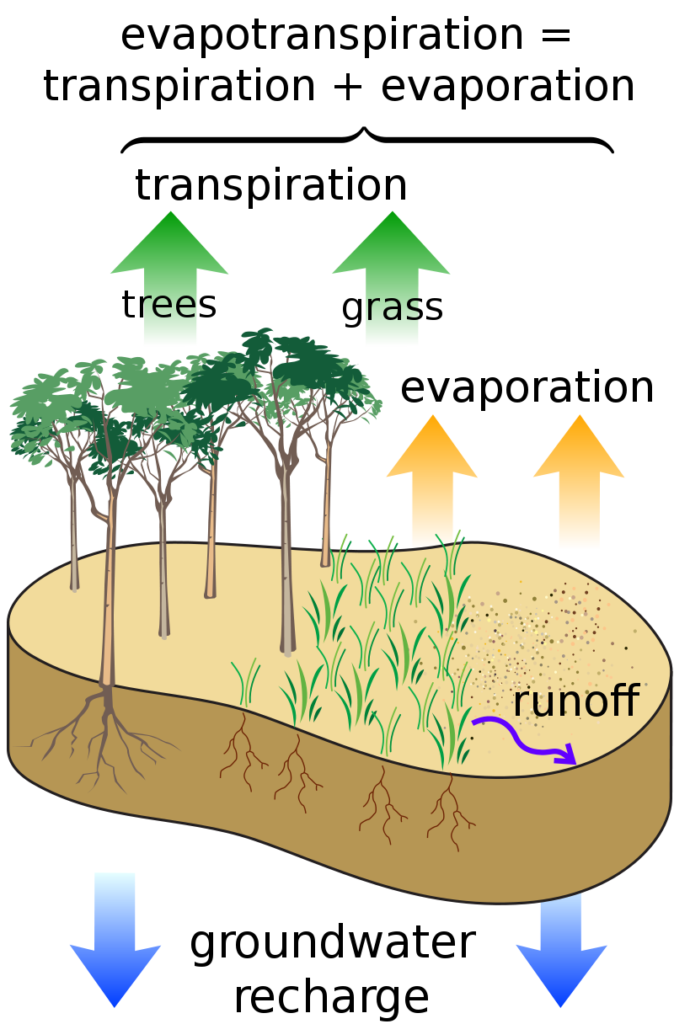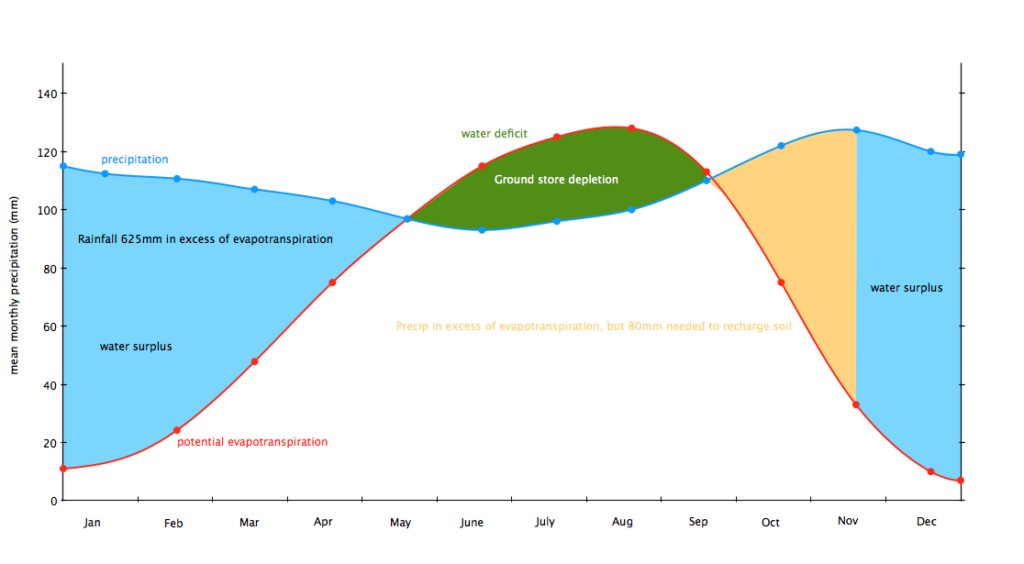Water Balance
The water balance is the balance of the input and output of water. The water balance of a specific area can be determined by calculating its input, output and storage changes. Input usually alludes to rainfall but may also be river inflow and groundwater inflow. Output pertains to evaporation, transpiration, river outflow, and groundwater outflow. Lastly, storage pertains to groundwater storage and soil moisture.
In an ideal situation, water input in a system is matched by water output, resulting in a balanced water system However, changes in the weather, natural processes, and human intervention can all have significant impacts on the water balance.
Water balance can be expressed by the formula P = Q + E +/- S.
Where,
P: Precipitation
Q: Run-off
E: evapotranspiration
S: Change in storage
The water balance has significant implications on the surrounding environment. It also dictates how much water is stored in a particular water system. Assessing the water balance in a given area is an effective method of determining its input and output. The survey of an area’s water balance can also help identify the factors that play a part in maintaining the water balance. Research and study of the water balance can prove beneficial for the proper management of water as a resource.
Elements of the Water Balance
Precipitation
Precipitation is the condensation of water vapour in the atmosphere that falls to the ground. It may come in the form of rain, snow, hail, ice pellets, and graupel.
When the atmosphere becomes saturated with water vapour, water condenses and changes from a gaseous state into a liquid state. There are two processes that can result in the air being saturated with water vapour – a reduction in the air’s temperature, or the addition of more water vapour. Usually, these two processes occur together making precipitation possible. Precipitation is heavily reliant on the amount of moisture in the atmosphere, and more moisture increases the chance of precipitation.
Rain is a common form of precipitation and can vary in size, shape, amount and temperature. The characteristics of rainfall depend on the weather conditions present at the time of its formation.
Hail is precipitation that falls in the form of solid water or ice. Hail is created by the repeated cycling of hailstones inside cumulonimbus clouds as a result of strong updrafts of wind. Hailstones inside the cloud gradually build up more layers of ice until it is heavy enough to fall to the ground. Precipitation in the form of hail does not require very low temperatures, as it is more reliant on the process that creates it than it is on temperature.
Snow and snowflakes are precipitation created in cold environments. These kinds of precipitation require the temperature of the earth below to be near or below freezing point. Snowflakes come in many different sizes, shapes and patterns. No two snowflakes are identical.
Evaporation
Evaporation is the process in which water in its liquid state turns into its gaseous state. Liquid water from the ground level evaporates into water vapour which then rises into the atmosphere above.
The rate of evaporation is determined by many factors such as air temperature, the amount of water vapour present in the air (humidity), solar radiation, altitude, and the current state of the ground level. Evaporation occurs the most in places that have high temperatures, brisk airflow, and large surfaces of water.
Evapotranspiration

Evaporation is the water’s phase change from a liquid state to a gaseous state. Liquid water is released into the air as water vapour. Transpiration, on the other hand, is the phase change of water from plants into water vapour. Evapotranspiration is simply the combination of these two processes. It is the sum of the amount of moisture released into the atmosphere by both evaporation and transpiration. The rate of evapotranspiration largely depends on the surrounding temperature. Evapotranspiration dictates all atmospheric conditions and is an essential element in studying the climate.
Potential evapotranspiration (PE)
Potential evapotranspiration is a process dependent on the availability of water. When the amount of moisture sufficiently meets the needs of plants and vegetation, the evaporation that results from this is called potential evapotranspiration. In other words, it is the amount of water that must be evaporated and transpired to maintain optimal environmental conditions.
In any place, the various environmental conditions and their effects produce water demand. When the water demand is greater than the amount of water present, the soil will be dry and lack moisture. This poses significant threats to the condition of the area. Plants need a certain amount of water to survive and are especially vulnerable to a lack of available moisture.
Actual evapotranspiration (AE)
Unlike the former, actual evapotranspiration is the actual amount of water vapour that comes from both evaporation and transpiration. It is dependent on factors such as the amount of available moisture, temperature, and humidity. It can otherwise be understood as the water that is being evaporated and transpired in an area.
The amount of water available also determines the amount of evapotranspiration. If there is no water or plants in an area, there is no evaporation or transpiration.
Soil moisture storage (ST)
Soil moisture storage is the amount of water the soil contains at any single instance. This amount relies on factors such as soil texture and organic matter content. Field capacity is the maximum amount of water that soil can contain. Soil with fine grains has larger field capacities than that with coarse grains. This means that in fine-grained soils, there is more water available for evapotranspiration. Soil cannot take in more water than its field capacity. A soil moisture storage of 0 means that the soil contains no water and has dried out.
Change in soil moisture storage (ÄST)
Water that is added or removed from the soil results in a change in soil moisture storage. This change in soil moisture storage can lie between the lower limit of 0 and the upper limit of the field capacity.
Deficit (D)
A soil moisture deficit is when potential evapotranspiration is greater than actual evapotranspiration. In other words, when the demand for water goes beyond what is available. A deficit only occurs when the soil contains no moisture, and the soil moisture storage is at 0. Determining the deficit allows one to discover how much water is needed to balance the system.
Surplus (S)
A surplus occurs when precipitation (P) exceeds the amount necessitated by potential evapotranspiration (PE). A surplus is when the amount of water present in an environment exceeds what it needs. The soil is at its field limit and can no longer accommodate the excess water. Instead, the surplus water runs off the soil’s surface and is deposited in nearby water sources such as streams. This increases the volume of water in a stream and leads to an increase in discharge. Determining the surplus can help predict the flooding of streams in the vicinity.
Surface run-off
Surface run-off occurs when the soil has reached its full capacity and can no longer absorb water. This water flows overland and drains into nearby water sources. Surface run-off is the result of a surplus of water from precipitation such as rainfall. Excess water can also come from melting snow, ice, and glaciers. Surface run-off is one of the most important processes in the water cycle.
An area of land that drains surface run-off into a common point is called a watershed.
Surface run-off that happens before a channel is reached is called a nonpoint source. This water can be contaminated by the various chemicals and materials that it encounters on the way to a water source. Possible contaminants found in the soil include pesticides, fertilisers, and petroleum. This contaminated run-off water can potentially pollute water supplies with harmful chemicals.
Percolation
Percolation is described as the downward movement of water into soil. However, percolation is not identical to infiltration. Percolation is merely the first stage of infiltration.
Frequently Asked Questions
What is the water balance?
The water balance refers to the equilibrium between the input and output of water in a specific area or system. It involves factors such as precipitation, evaporation, runoff, and groundwater recharge.
How is the water balance calculated?
The water balance is calculated by subtracting the total amount of water lost through evaporation and runoff from the total amount of precipitation in a given area during a specific period.
What happens when the water input exceeds the water output in the water balance?
When the water input exceeds the water output, it leads to a surplus of water, which can result in increased groundwater recharge, higher water levels in lakes and rivers, and potentially flooding.
What occurs when the water output exceeds the water input in the water balance?
When the water output exceeds the water input, it leads to a deficit of water, which can result in reduced groundwater levels, decreased water availability, and drought conditions.
Why is the water balance important in hydrology and water resource management?
The water balance helps in understanding the availability and distribution of water resources in a particular area. It is crucial for managing water supplies, predicting and mitigating water-related hazards, and planning sustainable water use.
References
- INTRODUCTION : CONCEPT OF WATER BALANCE. (n.d.). Retrieved from shodhganja: https://shodhganga.inflibnet.ac.in/bitstream/10603/69214/11/11_chapter%201.pdf
- The Water Balance. (n.d.). Retrieved from S-Cool: https://www.s-cool.co.uk/a-level/geography/river-profiles/revise-it/the-water-balance
- Water Balance. (n.d.). Retrieved from International Association of Hydrological Sciences: https://iahs.info/uploads/dms/16960.13-091-128-whole-Ch08_sm.pdf
- Water Balance. (n.d.). Retrieved from Tutur2U: https://www.tutor2u.net/geography/reference/water-balance-explained
- Water Balance of the Earth’s Surface (with diagram). (n.d.). Retrieved from Geography Notes: https://www.geographynotes.com/articles/water-balance-of-the-earths-surface-with-diagram/630
- Water Balance: Meaning, Components and Types | Hydrology | Geology. (n.d.). Retrieved from Geography Notes: https://www.geographynotes.com/hydrology/water-balance/water-balance-meaning-components-and-types-hydrology-geology/5241














